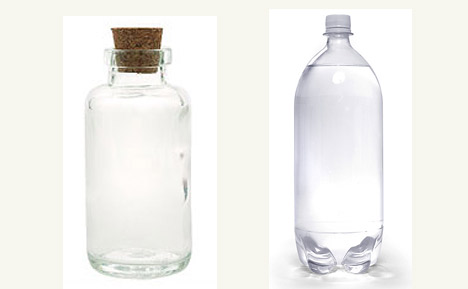Purify Water With Sunlight (Glass or Plastic?)
Here’s a survival tip… Did you know that you can purify water with sunlight?
The article “How to Purify Water with Sunlight” describes the process in more detail (it’s surprisingly simple). In short, it’s a matter of utilizing UV (ultraviolet) light from the sun to purify the water (with caveats mentioned in the article). This is a good method to know for an emergency.
For the purification process to be effective, you need to use the right kind of container…
The container that holds the water, must be of a material that is transmissive of UVA light.
What is Ultraviolet light?
Ultraviolet (UV) light is electromagnetic radiation with a wavelength shorter than that of visible light, in the range 10 nm to 400 nm. It is so-named because the frequencies are higher than those that humans identify as the color violet, and are invisible to humans.
UV radiation is of three types; UVA, UVB, and UVC. Out of these, only UVA and UVB types are harmful to our skin, damaging its surface and inner structure when exposed to the sun too long. The third type, UVC radiation, does not penetrate the atmosphere’s ozone layer and does not reach Earth.
UVA (400 nm – 320 nm)
UVB (320 nm – 290 nm)
UVC (290 nm – 100 nm)
With regards to water purification, UVA is our friend…
UVA interferes directly with the metabolism and destroys cell structures of bacteria.
UVA reacts with oxygen dissolved in the water, believed to also damage pathogens.
As the sun heats the water, and if the water temperatures rises above apprx. 120 °F, the disinfection process is three times faster.
Glass or Plastic
Colorless, transparent PET plastic water or soda bottles (2 liter or smaller size) with few surface scratches are best for use. The labels need to be removed and the bottles washed before the first use.
Abbreviated PET, or PETE, Polyethylene terephthalate, most plastic bottles are made from PET and are widely used for bottled water and soft drinks.
Plastic bottles made of ‘clear’ PET will pass most of the UVA radiation into the water inside for eventual purification (~ 6 hours in full sunlight of fairly clear water; bottle no larger than 2 liters).
Glass on the other hand is a pretty good UV blocker; but it depends on the exact type of glass, its thickness, and the UV band.
Normal glass is fairly opaque to the UVB band, blocking nearly 100% of it, which is the UV band usually considered to be the most damaging to your skin.
Normal glass is mostly transparent to UVA (to 330 nm), allowing 80% of the band’s radiation to pass through (UVA penetration is needed for water purification).
Some glass is treated, and will block most of the UVA and UVB. This will not work for water purification.
Knowing this, if you have ‘normal’ clear glass, untreated with anything, then you could expect 80% of the UVA light to provide disinfectant properties to the water contained inside, provided that the size of the bottle or container isn’t more than that of a typical 2-liter plastic soda bottle.
Having said all that, ‘PET’ plastic drinking water bottles or soda bottles (clear, non-colored) are more plentiful, lighter and easier to use for water purification in a situation where safer methods are not readily available (e.g. boiling).
If you are considering a more elaborate method of water purification using ordinary glass in some sort of configuration, be aware that most modern window glass will block much of the UVA due to its manufacture. You will need to check the specifications to know for sure.

